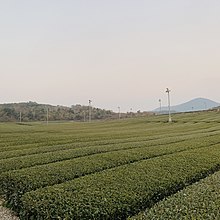O'Sulloc Tea
[3] Suh Sung-hwan started the company in 1979 with the aim of reviving the Korean tea tradition by regenerating the ecosystems and pristine land of Jeju Island, which at the time were uninhabited and uncultivated.
In 1980 O'Sulloc released the SULLOC-CHA brand, with their first green teas: Mansu, Cheonsu, and Baeksu.
[5] In 2002 O'Sulloc tea factories became the first in the sector to be certified under Hazard analysis and critical control points (HACCP).
In 2015 O'Sulloc won an iF Design Award and opened the Tea House at the National Museum of Modern and Contemporary Art.
[7][8][9] O'Sulloc tea is produced from four plantations, three of which are located on Jeju Island and one in mainland South Korea.
[10] The climate is humid subtropical giving a stable temperature all year round, with high annual precipitation.
The fields have the five key elements to make teas grow productively: soil, sunlight, water, wind and mist.
O'Sulloc is located in the south-western part of the island, where non-Andisols are widely distributed though rain and water sources.
[15] The local basaltic soils have an impact on the quality of tea and provide elements such as potassium, calcium, magnesium, and sulfur.
[18] All the tea produced in Jeju by O'Sulloc is planted, sustained, collected and harvested by machine.
[21] This originally infertile and rocky land was converted by O'Sulloc in 1983 and is now the largest tea field in South Korea with an area of 52,89 hectares.
[22] Hannam was developed in 1995 and the tea fields extend from the summit of Hallasan Mountain to the sea of Seogwipo.
[23] The plantation has had investment for organic farming, and is characterized by a mild climate, extensive sunshine, warm breezes and young trees with a high amino acid content.
These are differentiated by the addition of honey instead of sugar and the "Green Tea-derived Lactobacillus Scoby" developed by O'Sulloc.
[27] O'Sulloc offers a Roobibos tea, which is derived from the plant Rooibos, or Aspalathus linearis.
It has been studied for its potential health benefits as these berries contain particular lignans with anti-inflammatory, antioxidative, antiviral and sedative effects.
[35] The O’Sulloc Tea Museum was used as an example of a study on brand communication space based on experiential exhibition in 2015.
[36] The Tea Stone building was opened in March 2003[35] and consists of two floors of exhibition space, including Chusa Kim Jung-hee's Sehando and Chusa body-themed media art and an experience space for O'Sulloc's signature fermented tea "Sam Da-yeon".
It promotes products made of Jeju natural materials through five experience zones based on the five senses.
Ilohyang also won the Gold Prize at the Japan World Green Tea Contest in 2011 and 2014.
[46] Three commercial blended O'Sulloc tea samples were tested in a 2018 study by researchers at Sunchon National University and Pusan National University (South Korea) to develop a lexicon to describe the sensory flavor and aroma characteristics of fermented and blended teas, including Samdayeon Jeju tangerine (O'Sulloc, Jeju, South Korea), and Red papaya black tea (O'Sulloc).
[48] A study was conducted in 2020 by researchers at Chung-Ang University and Amore Pacific (South Korea) on the Antibacterial and Antifungal activity of the Lactiplantibacillus plantarum bacteria that was isolated from green tea collected in the O'Sulloc tea fields in Jeju.





